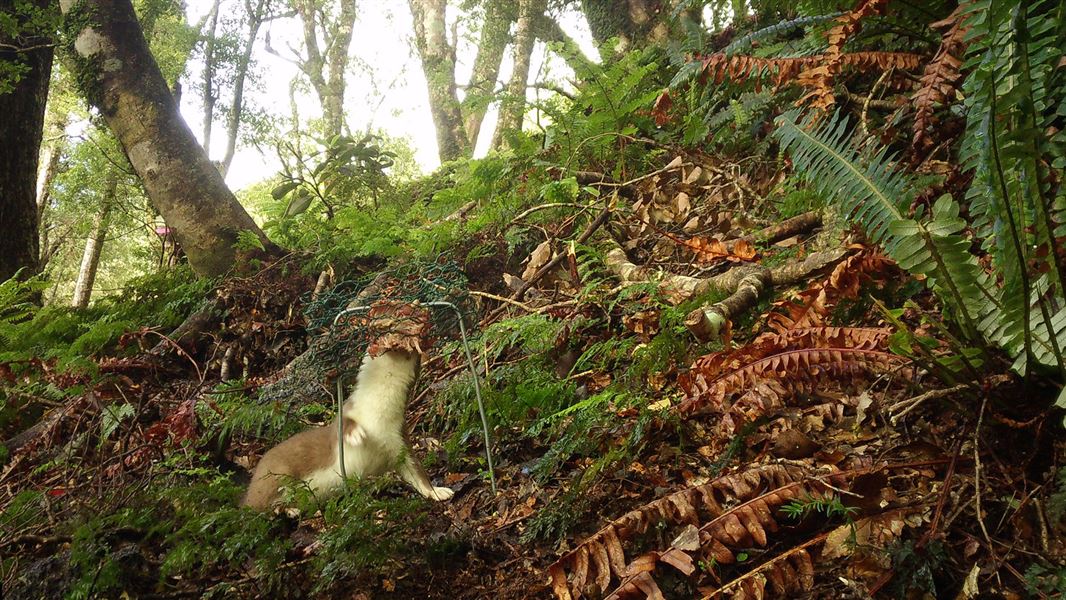Archived content: This media release was accurate on the date of publication.
Date: 23 April 2021
Predator monitoring cameras set up by DOC in December within an area recommended for joint DOC-OSPRI Project Kākā predator-control were collected in February. This was part of a trial for an improved camera-based predator monitoring method.
All ten cameras captured images of stoats.
DOC Wairarapa Supervisor Briggs Pilkington says this is a worrying indication of the number of predators in the area and demonstrates the importance of ongoing predator control.
“The Project Kākā zone is home to a range of taonga species, such as kākā, pōpokatea/whitehead and kakariki, where predator control is carried out by DOC and the Donnelly Flat Ground Control Volunteers. Stoats and possums are the main predators of kākā. Nesting females are particularly vulnerable while they are incubating eggs within tree cavities.
“It can be difficult to confirm stoats are in an area unless you catch them on camera even when you strongly suspect they’re around, so it’s a bit scary that these cameras have captured so many images. Given the locations of the cameras, it’s likely these are multiple animals, all within the Project Kākā area.
“You don’t need many stoats to have a problem.”
Stoats are incredibly efficient and relentless predators, able to climb and often use a strategy of killing everything in sight and storing the surplus for later. They have large home ranges, often between 40-100ha. At this time of year, they are moving around as young stoats seek out their own territory.
Stoat population numbers tend to increase when there is a reasonable rodent population, so seeing stoats confirms there is likely a healthy population of rats – another predator for taonga species.
Although the trapping the volunteer group carries out is essential for staying on top of predator numbers and is key to the successes of Project Kākā, ground-control methods have limits, Briggs Pilkington says.
“Ground-based control is good in accessible areas but can’t be easily scaled up to respond to immediate predator threats, especially over large areas with steep terrain like in the Tararua ranges. That’s why we seek to do operations with biodegradable 1080, which can be applied by air over large areas of rugged terrain to supress predators like rats and possums, and stoats.
“Ongoing predator-control is paramount. The actions we take now will supress populations for a while, but if you don’t keep on top of predators they will keep coming back. Taonga species and their habitat are increasingly under threat.”
Background information
Stoats
Stoats are 'public enemy number one' for New Zealand birds.
Stoats are agile climbers, and hunt at any time, day or night. They are known to be able to swim across water gaps of up to 1.5 km to reach islands. A stoat may be able to reach land at a greater distance than it can swim by ‘rafting’ on floating material such as driftwood logs.
The effect of stoat predation on the survival of many of New Zealand’s bird species cannot be underestimated. They are voracious and relentless hunters, described as having only two reasons for living – to eat and to reproduce.
Stoats are implicated in the extinction of South Island subspecies of bush wren, laughing owl and New Zealand thrush. Even a 3kg takahe or 2kg kakapo can be killed by a stoat, that also has a strategy of killing everything in sight and storing the surplus for later.
Stoats and rats are part of a complex predator-prey relationship associated with beech tree seed production. In a periodic ‘mast event’ of beech trees – where high levels of seed production occurs – stoat populations explode assisted by the increased food supply. Later, when the seed supplies run out, the higher numbers of predators have an even greater effect on populations of birds, wētā, bats and landsnails.
Tiakina Ngā Manu
Tiakina Ngā Manu is DOC’s national programme to protect taonga native species and forests through predator control.
This programme contributes to Predator Free 2050 through the sustained control of predators over large areas of conservation land to protect taonga native species and forests until the tools and methods to permanently remove predators are developed.
The Tiakina Ngā Manu predator control programme uses aerially applied 1080 toxin and large-scale trapping and other ground control methods to protect native birds, bats, frogs, lizards, giant land snails and forests at the most important conservation sites across the country.
The programme is focussed on protecting our most at-risk populations of taonga native species such as kōkako, kiwi, kākā, kea, whio/blue duck, kākāriki karaka/orange-fronted parakeet, mohua/yellowhead, tuke/rock wren, long and short tailed bats/pekapeka, frogs/pepeketua (Archey’s and Hochstetter’s frogs) and giant land snails.
Contact
For media enquiries contact:
Email: media@doc.govt.nz
